
Cascade, Seattle, Washington
Encyclopedia
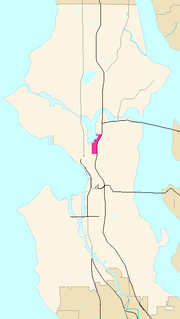
Downtown Seattle
Downtown is the central business district of Seattle, Washington. It is fairly compact compared to other city centers on the West Coast because of its geographical situation: hemmed in on the north and east by hills, on the west by the Elliott Bay, and on the south by reclaimed land that was once...
, Washington, USA; it constitutes the eastern portion of what has come to be known as South Lake Union. It is bounded by: Fairview Avenue North on the west, beyond which is the rest of South Lake Union; the Interstate 5
Interstate 5
Interstate 5 is the main Interstate Highway on the West Coast of the United States, running largely parallel to the Pacific Ocean coastline from Canada to Mexico . It serves some of the largest cities on the U.S...
interchange for Mercer St to the north, beyond which is Eastlake; Interstate 5
Interstate 5
Interstate 5 is the main Interstate Highway on the West Coast of the United States, running largely parallel to the Pacific Ocean coastline from Canada to Mexico . It serves some of the largest cities on the U.S...
on the east, beyond which is Capitol Hill; and Denny Way on the south, beyond which is Denny Triangle. It is surrounded by thoroughfares Mercer Street (eastbound), Fairview Avenue N. and Eastlake Avenue E. (north- and southbound), and Denny Way (east- and westbound). The neighborhood, one of Seattle's oldest, originally extended much further: west to Terry Avenue, south to Denny Hill
Denny Regrade, Seattle, Washington
The Denny Regrade is a neighborhood in Seattle, Washington, USA, that stretches north of the central business district to the grounds of Seattle Center. Its generally flat terrain was originally a steep hill, taken down as part of a mammoth construction project in the first decades of the 20th...
(regraded away
Regrading in Seattle
The topography of central Seattle was radically altered by a series of regrades in the city's 1st century of urban settlement, in what might have been the largest such alteration of urban terrain at the time....
1929–1931) on the South, and east to Melrose Avenue E through the area now obliterated by Interstate 5. Some recent writers consider Cascade to omit the northern "arm" (east of Lake Union), while others extend it westward to cover most of South Lake Union.
Historic structures in Cascade include St. Spiridon Russian Orthodox Cathedral, Immanuel Lutheran Church, and several defunct laundry blocks. In 2007, a development named Alley24 was built around the New Richmond Laundry Building, a City of Seattle Landmark located between John and Thomas Streets and Yale and Pontius Avenues North. The historic façade was maintained in the new design by architecture firm NBBJ
NBBJ
NBBJ is a global architecture, planning and design firm with offices in Beijing, Boston, Columbus, Dubai, London, Los Angeles, New York, San Francisco, Seattle, and Shanghai....
, who also relocated their headquarters to Alley24. The property is jointly owned by PEMCO
PEMCO
PEMCO Insurance is an American personal-lines mutual insurance company based in Seattle, Washington. Its name is an acronym for Public Employees Mutual Insurance Company.-History:In 1936, Seattle schoolteacher Robert J...
and Paul Allen
Paul Allen
Paul Gardner Allen is an American business magnate, investor, and philanthropist. Allen co-founded Microsoft with Bill Gates...
's development company Vulcan Inc.
Vulcan Inc.
Vulcan Inc. is an investment and project management company founded in 1986 by Paul Allen, co-founder of Microsoft, to manage his investments...
. Vulcan
Vulcan Inc.
Vulcan Inc. is an investment and project management company founded in 1986 by Paul Allen, co-founder of Microsoft, to manage his investments...
owns roughly approximately 6 acres in Cascade, a lower percentage of the land than in the rest of South Lake Union.
History
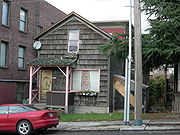
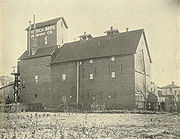
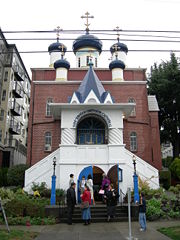
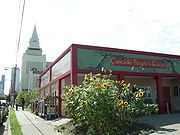


Pioneers
Like most of Seattle, the Cascade area was originally heavily forested. In the 1860s, David DennyDavid Denny
David Thomas Denny was a member of the Denny Party, who are generally collectively credited as the founders of Seattle, Washington, USA. Though he ultimately underwent bankruptcy, he was a significant contributor to the shape of the city...
and Thomas Mercer
Thomas Mercer
From An Illustrated History of the State of Washington, by Rev. H.K. Hines, D.D., The Lewis Publishing Co., Chicago, IL. 1893 A portrait of Mr. Mercer appears between pages 588 and 589...
first claimed portions of this land. However, initial development was a bit west of Cascade, at southwest Lake Union, which became a transportation nexus and where Denny established the lake's first sawmill. By the 1880s, more mills and more cleared land led to the origin of Cascade as a residential and industrial neighborhood, tied into water transportation.
Another notable pioneer was Margaret Pontius, known for her extensive work as what would now be called a foster parent. She and her husband, Rezius Pontius, lived in the neighborhood by 1885, and by 1889 had built a Queen Anne style
Queen Anne Style architecture
The Queen Anne Style in Britain means either the English Baroque architectural style roughly of the reign of Queen Anne , or a revived form that was popular in the last quarter of the 19th century and the early decades of the 20th century...
mansion, designed by John Parkinson, along Denny Way near what is now Yale Avenue.
Cascade was settled largely by Russians
Russian American
Russian Americans are primarily Americans who traces their ancestry to Russia. The definition can be applied to recent Russian immigrants to the United States, as well as to settlers of 19th century Russian settlements in northwestern America which includes today's California, Alaska and...
(some via Alaska
Alaska
Alaska is the largest state in the United States by area. It is situated in the northwest extremity of the North American continent, with Canada to the east, the Arctic Ocean to the north, and the Pacific Ocean to the west and south, with Russia further west across the Bering Strait...
), Swedes
Swedish American
Swedish Americans are Americans of Swedish descent, especially the descendants of about 1.2 million immigrants from Sweden during 1885-1915. Most were Lutherans who affiliated with the Evangelical Lutheran Church in America ; some were Methodists...
, Norwegians
Norwegian American
Norwegian Americans are Americans of Norwegian descent. Norwegian immigrants went to the United States primarily in the later half of the 19th century and the first few decades of the 20th century. There are more than 4.5 million Norwegian Americans according to the most recent U.S. census, and...
, and Greeks
Greek American
Greek Americans are Americans of Greek descent also described as Hellenic descent. According to the 2007 U.S. Census Bureau estimation, there were 1,380,088 people of Greek ancestry in the United States, while the State Department mentions that around 3,000,000 Americans claim to be of Greek descent...
. In 1894, the Cascade School (also designed by Parkinson) opened and the neighborhood acquired a name. As the neighborhood grew, the school expanded in 1904 and 1908. Cascade businesses in this era included sawmills, shingle mills, and boat yards along the lake, as well as cabinetry and furniture shops, grocery stores, laundries, and boarding houses.
Both landscape architect John C. Olmsted
John Charles Olmsted
John Charles Olmsted , the nephew and adopted son of Frederick Law Olmsted, was an American landscape architect. With his brother, Frederick Law Olmsted, Jr., he founded Olmsted Brothers, a landscape design firm in Brookline, Massachusetts. The firm is famous for designing many urban parks,...
(in 1903) and city planner Virgil Bogue
Virgil Bogue
Virgil Gay Bogue was born in Norfolk, New York, on July 20, 1846. He received a degree in civil engineering from the Rensselaer Polytechnic Institute in Troy, New York, in 1868. Bogue worked consecutively on Oroya Railway in Peru to 1879, the Northern Pacific Railway to 1886...
(in 1910–1911) believed that the neighborhood was best suited for industrial use, although Olmsted unsuccessfully proposed that there also be a small park on the lake. Denny Regrade No. 1
Regrading in Seattle
The topography of central Seattle was radically altered by a series of regrades in the city's 1st century of urban settlement, in what might have been the largest such alteration of urban terrain at the time....
(completed 1911) took out nearly half of Denny Hill, making Cascade more accessible from downtown Seattle. The Ford plant, designed by John Graham Sr. and built in 1914, was the Ford Motor Company
Ford Motor Company
Ford Motor Company is an American multinational automaker based in Dearborn, Michigan, a suburb of Detroit. The automaker was founded by Henry Ford and incorporated on June 16, 1903. In addition to the Ford and Lincoln brands, Ford also owns a small stake in Mazda in Japan and Aston Martin in the UK...
's first factory built west of the Mississippi River
Mississippi River
The Mississippi River is the largest river system in North America. Flowing entirely in the United States, this river rises in western Minnesota and meanders slowly southwards for to the Mississippi River Delta at the Gulf of Mexico. With its many tributaries, the Mississippi's watershed drains...
. When the Lake Washington Ship Canal
Lake Washington Ship Canal
The Lake Washington Ship Canal, which runs through the City of Seattle, Washington, connects the fresh water body of Lake Washington with the salt water inland sea of Puget Sound. The Ship Canal includes a series of locks, modeled after the Panama Canal, to accommodate the different water levels...
opened in 1917, maritime and industrial uses intensified. The area also became the center for the city's large laundries, as well as smaller machine shops. Cascade-area laundries played a crucial role in Seattle labor history, with a successful fight for the 8-hour day in the years 1917 through 1918.
Great Depression
When the Great DepressionGreat Depression
The Great Depression was a severe worldwide economic depression in the decade preceding World War II. The timing of the Great Depression varied across nations, but in most countries it started in about 1929 and lasted until the late 1930s or early 1940s...
coincided with the decline of the extractive economy in Greater Seattle, Cascade began to decline both economically and in terms of population, with its most stable remaining industries being shipbuilding and other marine activities. Howard Wright General Contractors were operating out of 409 Yale Avenue N, where they are still located as of 2008. There was also a business district between the 300 and 600 blocks of Eastlake, mainly on the west side of the street, including grocery stores, a pharmacy, a meat shop, automobile repair, furniture repair, a cabinetmaker, a beauty parlor, a barbershop, several drinking establishments, and a dye works. Although no buildings remain on the east side of the street, which abuts Interstate 5, many of these west-side buildings survive. However, with the freeway cutting it off from Capitol Hill, this is much less of a business district today.
Postwar Period
The decline of the Depression years was briefly arrested by World War IIWorld War II
World War II, or the Second World War , was a global conflict lasting from 1939 to 1945, involving most of the world's nations—including all of the great powers—eventually forming two opposing military alliances: the Allies and the Axis...
, as the U.S. Navy built a reserve center on the site of David Denny's former mill, just west of Cascade and Kenworth expanded a factory on Mercer Street. Decline resumed after the war, and was greatly exacerbated when the April 13, 1949 earthquake caused structural damage to the Cascade School. Controversy ensued over whether or not to repair the school, but it was ultimately demolished since local businesses led by the Seattle Times desired an increasingly industrial rather than residential character neighborhood. The school was replaced by a warehouse for the school district, while its playground remained as a public park.
The year 1949 also saw the first seeds of the "new" Cascade that would emerge almost half a century later: the Washington Teachers Credit Union was established, with quarters on Eastlake Avenue. It would become the Washington School Employees Credit Union (1963), and eventually part of PEMCO
PEMCO
PEMCO Insurance is an American personal-lines mutual insurance company based in Seattle, Washington. Its name is an acronym for Public Employees Mutual Insurance Company.-History:In 1936, Seattle schoolteacher Robert J...
Financial Services, still based in the Cascade Neighborhood as of 2008.
New zoning ordinances based on the 1956 Comprehensive Plan of Seattle forbade any new residential uses in Cascade. The plan also recommended two new freeways through the area. On the northern edge, the Bay Freeway
Bay Freeway
The Bay Freeway was the name of separate freeways proposed in Milwaukee, Wisconsin, and Seattle, Washington, United States. No portion of either freeway was ever constructed.-Milwaukee:...
would cover roughly nine city blocks between Mercer and Valley Streets, with ramps connecting to the Aurora Freeway
Washington State Route 99
State Route 99, abbreviated SR 99, commonly called Highway 99, is a numbered state highway in the U.S. state of Washington extending just under from Fife in the south to Everett in the north, with a gap in Tukwila.-Southern division:...
which had been constructed in 1932. The city lacked funding for the project and plans were eventually scrapped along with the R.H. Thomson Expressway. The second freeway was Interstate 5
Interstate 5
Interstate 5 is the main Interstate Highway on the West Coast of the United States, running largely parallel to the Pacific Ocean coastline from Canada to Mexico . It serves some of the largest cities on the U.S...
, which was constructed in 1962. More than seven blocks of residences and retail businesses on the east side of Eastlake were razed to make way for Interstate 5
Interstate 5
Interstate 5 is the main Interstate Highway on the West Coast of the United States, running largely parallel to the Pacific Ocean coastline from Canada to Mexico . It serves some of the largest cities on the U.S...
. The freeway cut Cascade off entirely from neighboring Capitol Hill
Capitol Hill, Seattle, Washington
Capitol Hill is the most densely populated residential district in Seattle, Washington, United States. It is the center of the city's gay and counterculture communities, and is one of the city's most prominent nightlife and entertainment districts....
. Previously they had been tied together by multiple streets and stairways. (The upper half-block of the E. Republican Street Stairway or Republican Hill Climb east of Melrose Ave E. remains east of the freeway, and has status as a city landmark; it once extended two blocks farther, down to Eastlake Ave E.) Currently, the only remaining direct route between the two is Denny Way at the south border of the neighborhood.
1960s
The Seattle Times Building had been built in 1930 just west of Fairview Avenue.Seattle Times; in the 1960s, the Times purchased and razed acres of homes near its headquarters for parking lots and future development opportunities. (One building they purchased was, for a time, operated as the Seattle Concert Theater, but even that was "hastily razed" in the early 1980s to "head off a landmarks designation".) Karin Link remarks: "The relationship between the Seattle Times and the Cascade neighborhood is still considered problematic."In the 1960s, the University of Washington
University of Washington
University of Washington is a public research university, founded in 1861 in Seattle, Washington, United States. The UW is the largest university in the Northwest and the oldest public university on the West Coast. The university has three campuses, with its largest campus in the University...
's College of Architecture and Urban Planning described the area as "blighted". The 1969 Bay Freeway
Bay Freeway
The Bay Freeway was the name of separate freeways proposed in Milwaukee, Wisconsin, and Seattle, Washington, United States. No portion of either freeway was ever constructed.-Milwaukee:...
plan for a proposed elevated freeway to connect Interstate 5 with Seattle Center
Seattle Center
Seattle Center is a park and arts and entertainment center in Seattle, Washington. The campus is the site used in 1962 by the Century 21 Exposition. It is located just north of Belltown in the Lower Queen Anne neighborhood.-Attractions:...
would have cut off the neighborhood from the Lake, but was voted down in 1972. Cascade struggled on as a blue-collar residential and light industrial neighborhood.
1970s
In the early 1970s, activists including a University of WashingtonUniversity of Washington
University of Washington is a public research university, founded in 1861 in Seattle, Washington, United States. The UW is the largest university in the Northwest and the oldest public university on the West Coast. The university has three campuses, with its largest campus in the University...
student named Frank Chopp
Frank Chopp
Frank Chopp is a Democratic member of the Washington House of Representatives, representing the 43rd district since 1995. He is the current Speaker of the House. His district covers the neighborhoods of Fremont, Wallingford, the University District and Madison Park, all in Seattle.-Biography:Frank...
began the Cascade Shelter Project, setting up geodesic domes on vacant lots to live in. A 1975 report by Folke Nyberg and Victor Steinbrueck
Victor Steinbrueck
Victor Steinbrueck was a Seattle architect, and University of Washington faculty member, and best known for his efforts to preserve the city's Pioneer Square and Pike Place Market.-Biography:...
included Cascade as a historic residential section of Seattle
, and in 1977 the Housing In Cascade study by Paul Schell
Paul Schell
Paul Schell, born Paul Schlachtenhaufen on October 8, 1937, in Fort Dodge, Iowa, was the 50th mayor of Seattle, Washington. His four-year term as mayor began on January 1, 1998....
, then Director of Seattle Department of Community Development, recommended a "Special Review District" in Cascade. However, the city council took no action on the proposal.
1980s
As the local economy strengthened in the late 1980s, Cascade's cheap land and central location began to attract new uses. The northwest corner of the neighborhood became the campus of the Fred Hutchinson Cancer Research CenterFred Hutchinson Cancer Research Center
The Fred Hutchinson Cancer Research Center, is one of the world’s leading cancer research institutes...
and at the north tip of Cascade, the old City Light Steam Plant (a decommissioned electrical generation facility) became the headquarters of Zymogenetics
ZymoGenetics
ZymoGenetics is a biotechnology/pharmaceutical company based in Seattle, Washington, involved in the development of therapeutic proteins.The company was founded in 1981 by Professors Earl W. Davie and Benjamin D. Hall of the University of Washington and 1993 Nobel Laureate in Chemistry Michael...
. Gentrification
Gentrification
Gentrification and urban gentrification refer to the changes that result when wealthier people acquire or rent property in low income and working class communities. Urban gentrification is associated with movement. Consequent to gentrification, the average income increases and average family size...
had begun. Although a proposal to transform a north-south corridor just west of Cascade into a 74 acres (29.9 ha) park was twice defeated by the voters (in 1995 and in 1996), gentrification continued apace, largely driven by tech billionaire and developer Paul Allen
Paul Allen
Paul Gardner Allen is an American business magnate, investor, and philanthropist. Allen co-founded Microsoft with Bill Gates...
's Vulcan Northwest group.
1990s
Two large changes in the south part of Cascade in the 1990s were the demolition of the old St. Demetrios Church (along with the Overall Laundry) to build the new REI flagship store, and the demolition of the 1907 wood-frame Lillian Apartments by Vulcan Northwest. Both of these changes were opposed by preservationists; the latter was opposed particularly virulently by low-income housing advocates.Notable residents
Teamsters labor leader Dave BeckDave Beck
Dave Beck was an American labor leader, and president of the International Brotherhood of Teamsters from 1952 to 1957...
grew up in and around Cascade, attended the Cascade School, and delivered newspapers there. He followed his mother into laundry work, which brought him into labor organizing.
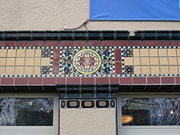
Seattle Art Museum
The Seattle Art Museum is an art museum located in Seattle, Washington, USA. It maintains three major facilities: its main museum in downtown Seattle; the Seattle Asian Art Museum in Volunteer Park on Capitol Hill, and the Olympic Sculpture Park on the central Seattle waterfront, which opened on...
. Kuvshinoff arrived in Cascade from Russia
Russian Empire
The Russian Empire was a state that existed from 1721 until the Russian Revolution of 1917. It was the successor to the Tsardom of Russia and the predecessor of the Soviet Union...
in 1915. His father, the Rev. Vasily Kuvshinoff, brought with him icons and relics given to him by the Romanovs, which he bequeathed to St. Spiridon Orthodox Cathedral, where he officiated. Nicolai Kuvshinoff appears to have painted religious murals in the Cathedral. From 1955 to 1960 Kuvshinoff and his wife lived and worked in Paris
Paris
Paris is the capital and largest city in France, situated on the river Seine, in northern France, at the heart of the Île-de-France region...
, but they returned to Cascade, where they remained until Nicolai's death in 1997 (Bertha lived two years longer). During most of their time in Cascade, they lived in the former Rodgers Tile Company building at 117-121 Yale Ave. N, later the 911 Contemporary Arts Center and now the Feathered Friends outdoor equipment shop.
Cascade Playground
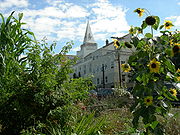
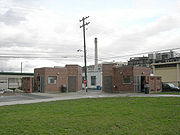
P-Patch
A P-Patch is a parcel of property used for gardening allotments; the term is specific to Seattle, Washington. The "P" originally stood for "Picardo", after the family who owned Picardo Farm in Seattle's Wedgwood neighborhood, part of which became the original P-Patch. -List of P-Patches:#Jackson...
(allotment garden). Improvements to the Cascade Playground play areas, field, and entrance were unveiled in spring 2005, financed by the Pro Parks Levy. Sharing a city block with the playground and P-Patch is the Cascade People's Center, a volunteer organization that partners with over 100 businesses, churches, organizations, and community groups to address advocacy for social and economic justice.
By 1931, although most of this block had come to be owned by the City of Seattle or the School Board
Seattle Public Schools
Seattle Public Schools is the school district serving Seattle, Washington, USA. Its headquarters are in the John Stanford Center for Educational Excellence.-List of schools:...
, a number of houses remained owned by individuals. By the end of 1931, however, the owners of these houses had sold out and the buildings were removed (although some basements may still be intact under the park surface). There was debate in the neighborhood over building the playground; in 1934, the pro-playground group eventually prevailed. Still, as late as 1937, the Fairview-Stewart Improvement Club was protested that the Cascade School was old and out of date, itself not worth preserving, and that the increasingly industrial and commercial neighborhood did not need a playfield.
Between 1934 and 1939, WPA
Works Progress Administration
The Works Progress Administration was the largest and most ambitious New Deal agency, employing millions of unskilled workers to carry out public works projects, including the construction of public buildings and roads, and operated large arts, drama, media, and literacy projects...
workers built a retaining wall (only part of which survive), the rest rooms at the northeast corner of the park, and a wading pool (which originally was part of a Japanese stone garden
Japanese rock garden
The or "dry landscape" gardens, often called "Zen gardens", are a type of garden that features extensive use of rocks or stones, along with plants native to rocky or alpine environments that were influenced mainly by Zen Buddhism and can be found at Zen temples of meditation.- Overview :Japanese...
).
By the 1970s, according to the Seattle Department of Neighborhoods, "the playground site was somewhat bleak and known by locals as the 'Sahara Desert'". A 1971 renovation included a mural on the retaining wall, funded by the Seattle Arts Commission and designed by Mike Love and George Shayler. This was followed by another round of improvements in 2005.
Landmarks and Registered Historic Places
See also the listing of Landmarks and Registered Historic Places in South Lake Union, most of which fall within what are considered by some to be the borders of the Cascade neighborhood.
| Building or structure |
Address | Listing | Photo |
|---|---|---|---|
| Ford Assembly Plant Building Now Public Storage |
1155 Valley St. | Seattle landmark |  |
| Immanuel Lutheran Church | 1215 Thomas St. | Seattle landmark NRHP |
 |
| Jensen Block | 601-611 Eastlake Ave. E | Seattle landmark |  |
| Lake Union Steam Plant and Hydro House Now Zymogenetics |
1179 Eastlake Ave. E | Seattle landmark |  |
| New Richmond Laundry Now part of the Alley24 development |
224 Pontius Ave. N | Seattle landmark |  |
| St. Spiridon Russian Orthodox Cathedral | 400 Yale Ave. N | Seattle landmark |  |
| Supply Laundry Unused as of 2008 |
1265 Republican St. | Seattle landmark |  |
In addition, the surviving portion of the East Republican Street Stairway that once connected Cascade to Capitol Hill is a designated Seattle landmark. However, the portion of it that remains is separated from Cascade by Interstate 5.
| Building or structure |
Address | Listing | Photo |
|---|---|---|---|
| East Republican Street Stairway | Between Melrose Ave. E and Bellevue Ave. E; Originally extended beyond Bellevue Ave. E to Eastlake Ave. E |
Seattle landmark |  |
Additional references
- Fiset, Louis (9 April 2001). Seattle Neighborhoods: Cascade and South Lake Union – Thumbnail History. HistoryLink.org Essay 3178, April 9, 2001. Retrieved on 2007-09-09 from http://www.historylink.org/essays/output.cfm?file_id=3178.. This document discusses many individual buildings, past and present, as well as the people of the neighborhood at various times in its history. It also has an extensive bibliography.

